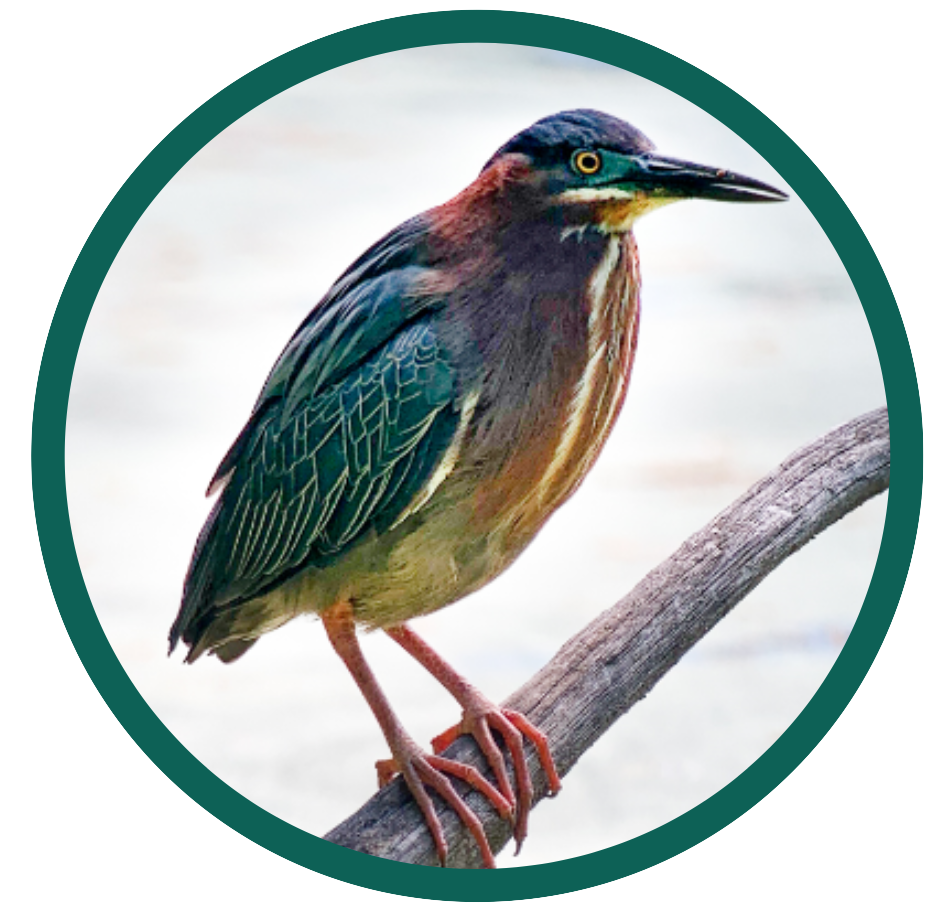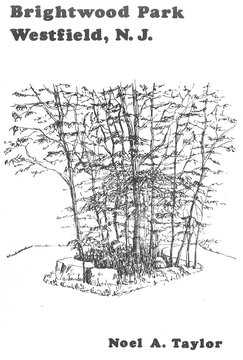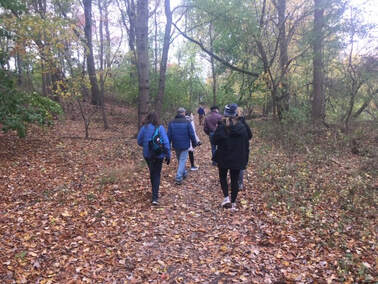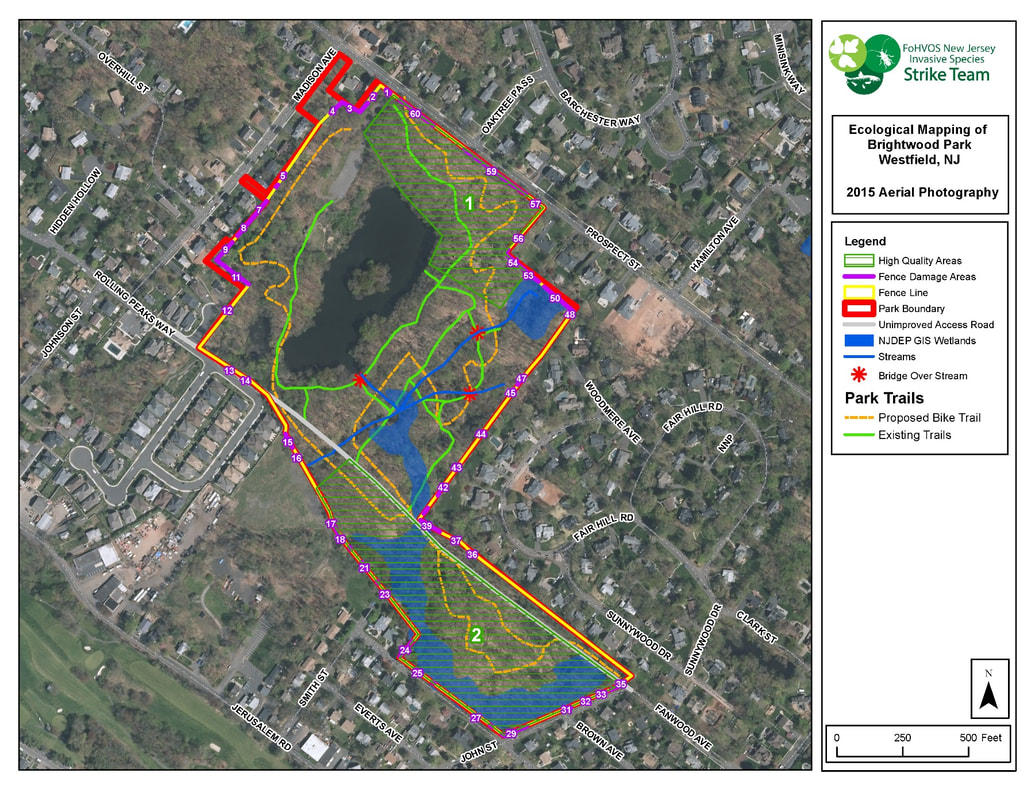Brightwood Park Ecology
October 2023
Site Visit and Report from Rutgers Agriculture and Natural Resources Dept
In October, 2023, we were delighted to host Jean Epiphan, an Agriculture & Natural Resources Agent and Assistant Professor at Rutgers University, to assess our preservation efforts at Brightwood, and give us guidance on how best to move forward.
Her report includes the exciting discovery of two species of native blueberry and azalea that are critical to protect and preserve. It also provides guidance for our restoration efforts.
Her report includes the exciting discovery of two species of native blueberry and azalea that are critical to protect and preserve. It also provides guidance for our restoration efforts.
1981
Noel TaylorIn 1981, shortly after the two ponds were created, Noel Taylor, a biology teacher at Westfield High School, published a detailed book about the ecology at Brightwood Park. The full text is available HERE. He begins with this description of Brightwood Park:
A quiet sanctuary for all lovers of nature where one can relax and listen to the sounds of nature, enjoy its beauty or begin to understand the lesson that man depends on wildlife for survival. The book described the geology and early history of the park, delinenated the forest areas from the disturbed areas, described the remains of homesites and outlined the ecology of the park in detail.
The book also provides a trail guide to the trees, vines, ferns and flora in the park, identifying over 350 species of plants and providing a trail guide to the birds and other fauna. It includes a discussion of the ecology of the pond, which was new at the time, and the ecology of the undisturbed forested areas. He concludes with this warning: The worst thing that can happen - will happen in the 1980s - is not the energy depletion, economic collapse, limited nuclear war, or conquest by a totalitarian government. As terrible as these catastrophes would be for us, they can be repaired within a few generations. The one process ongoing in the 1980s that will take millions of years to correct is loss of genetic and species diversity by the destruction of natural habitats. This is the folly our descendants are least likely to forgive us. - O.E. Wilson, Harvard Magazine, January-February 1980 |
2008
Partnership with the Rahway River AssociationIn 2008, Michael Van Clef authored the 2008 Brightwood Park Stewardship Plan prepared for the town and the Rahway River Watershed Association.
From the summary:
That report laid out a blueprint of how to restore the park’s health. Unfortunately, due to the 2008 financial crisis, the town did not implement the recommended action plan. FOBP has been using that Plan as a blueprint for ecological restoration of the park. A Powerpoint presentation describing this study is available for download HERE |
2021
|
Ecological Mapping - Entire Park
|
2021 - Ecology AssessmentsMichael Van Clef, Ph.D, of Ecological Solutions, LLC, returns
In the summer of 2021, Van Clef returned to the park to re-evaluate the ecological conditions of the park with an eye to its current restoration potential and to comment on the potential plan for mountain bike use. The good news was Van Clef believes that the park can still be rehabilitated. With respect to additional trails in the park, Van Clef wrote: It is recommended that any new trails (regardless of use) not be placed within the two high-quality areas [See map below] to minimize disturbance/destruction of native plant communities and minimize the spread of invasive species such as Japanese Stiltgrass. Additionally, any new trails within the Park should avoid wetlands and stream crossings as these areas are sensitive to disturbance that would degrade wetland and stream health. The publicly available NJDEP GIS wetlands layer is only approximate (not determined through a formal wetlands delineation) - for example, there is a large unmapped wetland area (potentially a vernal pool) located just south of a mapped wetland patch along the eastern boundary of the Park. 4 Van Clef shaded the high-quality areas in green stripes on a NJDEP GIS map. He specifically noted that the wetlands depicted on that map were only approximate and not a formal delineation. He recommended that the town contact the NJDEP with respect to the need for a permit if new trails are to be developed. Full Report Van Clef commented that the intensity of trail use dictates the trail maintenance required. Pedestrian use requires little trail maintenance. With respect to Mountain Bike use, he recommends:
Emile DeVito, Ph.D., Manager of Science and Stewardship, New Jersey Conservation Foundation and Member of Board of Directors of the Rahway River Watershed Association
Like Van Clef, Devito also found gem areas of the park that should be preserved. In particular, pristine forest areas have old soil that has not yet been infiltrated by invasive plants. Its carbon content and density are protective – provided it is not disturbed by land use. DeVito recommends that active recreation be limited in the park to previously disturbed areas where invasive plants are already present. However, DeVito also noted that areas undergoing ecological restoration should not be used for active recreation. Such areas should be off limits except for very limited passive recreation on trails. DeVito also suggested that streams only be crossed by NJDEP permitted bridges. Finally, he noted that the town should consider the small overall area of the park as it considers further trail development. |
We look forward to a “bright” future collaborating with the town to develop a sustainable nature park.





